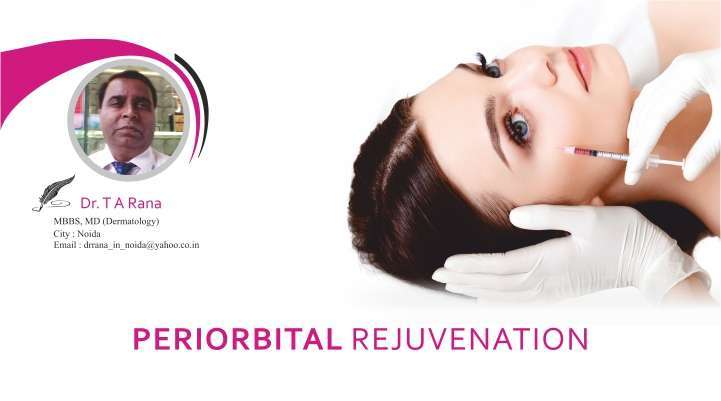Guideline for local anesthesia in use of injectable fillers in perorbital region
- Historically anesthesia protocol constituted the pre-treatment part of the injecting regimen
- Recently some physicians have started to combine anesthesia such as lido caine with injectable dermal fillers itself
- The combined solution of dermal fillers and anesthesia is administer together
Nerve Blocks
- Nerve blocks total anesthetic to the area being treated by anesthetizing the main trunk of nerve.
- In tissue infiltration anesthesia is injected just below the skin in the surrounding area that is to be treated with dermal filler.
Physical Aids
- Physical aids include vibrating, icing and cooling (Zimmer chiller) provide a temporary anesthetic condition so that the pain of injection is somewhat mitigated.
Environmental Aids
- Finally, environmental aspects can be modulated so that anxieties of the patient are lessened. These include soothing music and talking softly (talkesthesia) with patient throughout the injection period.
Treatment Supplies for Dermal Fillers Injection
- Protocols for pretreatment anesthesia & dermal fillers
- 27G 1 ¼ Inch and ½ inch needles
- 30 G 1-inch or 27 G 1¼ inch or ½ inch needle for numbering
- Non –latex-Gloves
- Mirror
- 4×4or 3×3 gauze pads
- Sharps container
- Camera for before and after photos
- Signed consent form
- White eyeliner pencil for marking
- Alcohol pads for cleansing area
Injection Technique for Facial Beauty
- The technique focuses on trying to decipher objective parameters in creating a template to maximize each individual’s facial beauty.
- The technique offered is personal and as is evidence below not a unique concept.
- It in no way represents the best or sole method to non-surgically release the patient’s facial beauty potential.
Injection Techniques
- Kane’s Technique – After evaluation and marking of the tear trough topical anesthetic ointment is applied to lower eyelids at least 30 minutes before the injection.
- After preparation of skin with alcohol, a 30 or 32 gauge needle is inserted for injection.
- The skin of the lower lid is spread and held at some tension with the non injection hand.
- The skin is inspected carefully for visible vessels before catching needle stick.
- The deepest portion of the middle tear trough is treated first.
- The needle is threaded below the surface of the skin above orbicularis oculi.
- The parallel threads of the filler are injected cephalad and caudal to the tear trough.
- At least, the junction of the middle and lateral 3rd of the inferior of the rim. If the tear trough is deep the direction of the middle if change throughout the injection so that the filler is applied to cross has fashion.
- Stutman And Codner Technique – After the marking confirmed by the patient, HA is injected deep in the pre-periosteal plane, to reduce visibility of the product.
- The HA is placed beneath the insertion of the middle orbicularis muscle at the maxilla and continues laterally needle with care not to inject super facial.
A variety of HA injection technique may be utilized depending on the indications including antigrade or retrograde.
1 linear threading 2 serial puncture 3 crosshatching and sub cutaneous 4 epi-periosteal
In tear through region inject along the inferior orbital rim in pre-periosteal plan and massage the area.
- The Kenneth and Samantha Steinsapir Technique-The goal was to place allquots of the filler in the pre-periosteal tissues just inferior to the orbital rim.
- The bony orbital rim is free of significant vascular structures from the base of the anterior lacrimal crest to the lateral canthal tendon.
- The filler was introduced by using a serial puncture technique.
- The orbital rim was digitally palpated and needle rotated so that the bevel was parallel to the skin an advanced to flush on the periosteum.
Key Point for Tear Trough Injection
- Low- viscosity HA can be safely injected to correct tear trough deformity.
- High- viscosity HA and non-biodegradable agents should not be injected in the tear trough.
- Injections must be at a supra-periosteal level of the orbital rim under defect.
- One should be cautious around the infraorbital foramen.
- The HA filler should be gently massaged for even distribution; strong massage should be avoided.
- Overcorrection should be avoided, HA is hydrophilic and may cause a swelling due to its properties of attraction water. There is a study which shows that HA can also cause stimulation of de novo production of collagen. Hence, it is best to under correction the tear trough area to prevent bulges under the eye. A touch can always be done if necessary when the patient comes for a follow up.
Post Procedure Care
- Face down sleeping should be avoided.
- Refrain from strenuous activity for one or two days.
- Apply ice periodically for 24 hrs to 48 hrs.
- If any correction for touch up, call after one week.
- If any plane lumpiness in treated area, give the finger massage itself.
Conclusions
- Tear trough deformity can be corrected with an HA filler.
- It is less invasive and there may be minimal downtime due to swelling and bruising.
- The volume injected varies from patient to patient and over correction should be avoided.
- Better results will be achieved if the patient is reassessed in two or four weeks and then additional treatment is performed to achieve complete correction.
- Care should be taken to avoid injection through the orbital septum, to avoid accentuating pseudoherniation.
*-*-*






